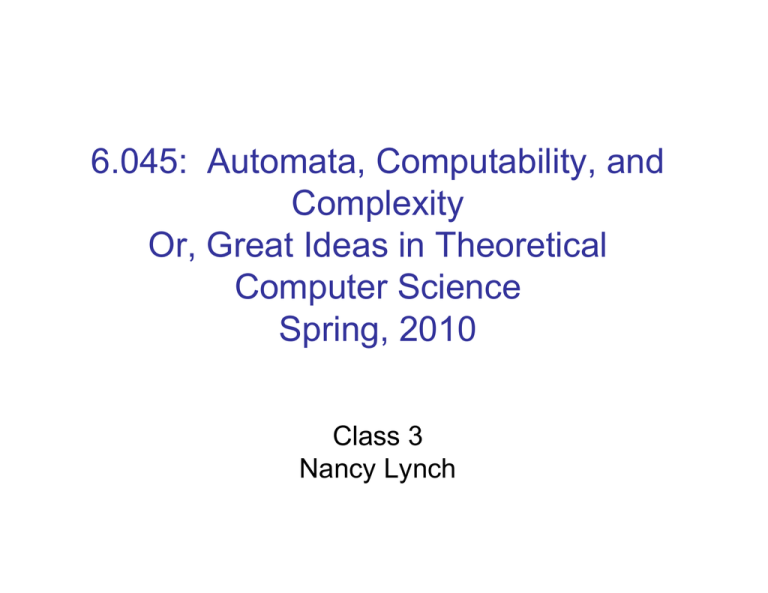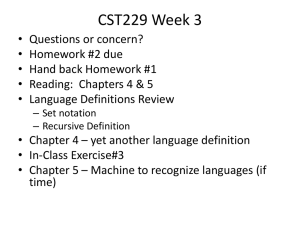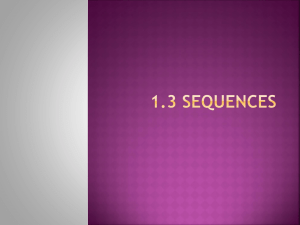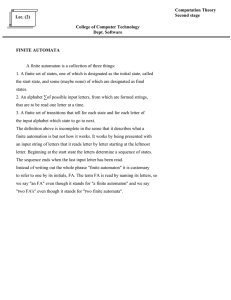6.045: Automata, Computability, and Complexity Or, Great Ideas in Theoretical Computer Science
advertisement

6.045: Automata, Computability, and
Complexity
Or, Great Ideas in Theoretical
Computer Science
Spring, 2010
Class 3
Nancy Lynch
Today
• Finite Automata (FAs)
– Our third machine model, after circuits and decision trees.
• Designed to:
– Accept some strings of symbols.
– Recognize a language, which is the set of strings it accepts.
• FA takes as its input a string of any length.
– One machine for all lengths.
– Circuits and decision trees use a different machine for each length.
• Today’s topics:
–
–
–
–
–
Finite Automata and the languages they recognize
Examples
Operations on languages
Closure of FA languages under various operations
Nondeterministic FAs
• Reading: Sipser, Section 1.1.
• Next: Sections 1.2, 1.3.
Finite Automata and the
languages they recognize
Example 1
• An FA diagram, machine M
0
0,1
1
1
a
1
b
c
d
0
0
• Conventions:
a
Start state
Accept state
1
b
Transition from a to b on
input symbol 1.
Allow self-loops
Example 1
0
0,1
1
1
a
1
b
c
d
0
0
• Example computation:
– Input word w: 1 0 1 1 0 1 1 1 0
– States:
a b a b c a b c d d
• We say that M accepts w, since w leads to d, an
accepting state.
In general…
• A FA M accepts a word w if w causes M to follow a
path from the start state to an accept state.
• Some terminology and notation:
Finite alphabet of symbols, usually called Σ.
In Example 1 (and often), Σ = { 0,1 }.
String (word) over Σ: Finite sequence of symbols from Σ.
Length of w, | w |
ε, placeholder symbol for the empty string, | ε | = 0
Σ*, the set of all finite strings of symbols in Σ
Concatenation of strings w and x, written w ◦ x or w x.
L(M), language recognized by M:
{ w | w is accepted by M }.
– What is L( M ) for Example 1?
–
–
–
–
–
–
–
–
Example 1
0
0,1
1
1
a
1
b
c
d
0
0
• What is L( M ) for Example 1?
• { w ∈ { 0,1 }* | w contains 111 as a substring }
• Note: Substring refers to consecutive symbols.
Formal Definition of an FA
• An FA is a 5-tuple ( Q, Σ, δ, q0, F ), where:
– Q is a finite set of states,
– Σ is a finite set (alphabet) of input symbols,
– δ: Q × Σ → Q is the transition function,
The arguments of δ
are a state and an
alphabet symbol.
The result is a state.
– q0 ∈ Q, is the start state, and
– F ⊆ Q is the set of accepting, or final states.
Example 1
What is the 5-tuple (Q, Σ, δ, q0, F)?
Q = { a, b, c, d }
Σ = { 0, 1 }
δ is given by the state diagram, or
alternatively, by a table:
0
• q0 = a
a a
• F={d}
b a
c a
d d
•
•
•
•
1
b
c
d
d
Formal definition of computation
• Extend the definition of δ to input strings and states:
δ*: Q × Σ* → Q, state and string yield a state
δ*( q, w ) = state that is reached by starting at q and
following w.
• Defined recursively:
δ*( q, ε ) = q
δ*( q, w a ) = δ( δ*( q, w ), a )
string
symbol
• Or iteratively, compute δ*( q, a1 a2 … ak) by:
s:=q
for i = 1 to k do s := δ( s, ai )
Formal definition of computation
• String w is accepted if δ*( q0, w ) ∈ F, that is,
w leads from the start state to an accepting
state.
• String w is rejected if it isn’t accepted.
• A language is any set of strings over some
alphabet.
• L(M), language recognized by finite
automaton M = { w | w is accepted by M}.
• A language is regular, or FA-recognizable, if
it is recognized by some finite automaton.
Examples of Finite Automata
Example 2
• Design an FA M with L(M) = { w ∈ { 0,1 }* | w
contains 101 as a substring }.
0
1
0,1
1
a
0
1
b
c
d
0
• Failure from state b causes the machine to remain
in state b.
Example 3
• L = { w ∈ { 0,1 }* | w doesn’t contain either 00 or
11 as a substring }.
0,1
b
0
a
0
1
0
1
c
d
1
• State d is a trap state = a nonaccepting state that
you can’t leave.
• Sometimes we’ll omit some arrows; by convention,
they go to a trap state.
Example 4
• L = { w | all nonempty blocks of 1s in w have odd length }.
• E.g., ε, or 100111000011111, or any number of 0s. 0
• Initial 0s don’t matter, so start with:
a
• Then 1 also leads to an accepting state, but it should be a
different one, to “remember” that the string ends in one 1.
0
a
1
b
Example 4
•
L = { w | all nonempty blocks of 1s in w have odd length }.
0
• From b:
– 0 can return to a, which can
represent either ε, or any string that
is OK so far and ends with 0.
– 1 should go to a new nonaccepting
state, meaning “the string ends with
0
two 1s”.
a
1
1
a
b
1
c
0
•
Note: c isn’t a trap state---we can accept some extensions.
b
Example 4
• L = { w | all nonempty blocks of 1s in w have odd length }.
0
0,1
a
• From c:
1
0
b
1
1
0
c
d
Trap state
– 1 can lead back to b, since future acceptance decisions are the
same if the string so far ends with any odd number of 1s.
• Reinterpret b as meaning “ends with an odd number of 1s”.
• Reinterpret c as “ends with an even number of 1s”.
– 0 means we must reject the current string and all extensions.
Example 4
• L = { w | all nonempty blocks of 1s in w have odd length }.
0
0,1
a
1
0
b
1
0
c
d
1
• Meanings of states (more precisely):
a: Either ε, or contains no bad block (even block of 1s followed by 0)
so far and ends with 0.
b: No bad block so far, and ends with odd number of 1s.
c: No bad block so far, and ends with even number of 1s.
d: Contains a bad block.
Example 5
• L = EQ = { w | w contains an equal number of 0s
and 1s }.
• No FA recognizes this language.
• Idea (not a proof):
– Machine must “remember” how many 0s and 1s it has
seen, or at least the difference between these numbers.
– Since these numbers (and the difference) could be
anything, there can’t be enough states to keep track.
– So the machine will sometimes get confused and give a
wrong answer.
• We’ll turn this into an actual proof next week.
Language Operations
Language operations
• Operations that can be used to construct
languages from other languages.
• Recall: A language is any set of strings.
• Since languages are sets, we can use the usual
set operations:
–
–
–
–
Union, L1 ∪ L2
Intersection, L1 ∩ L2
Complement, Lc
Set difference, L1 - L2
• We also have new operations defined especially
for sets of strings:
– Concatenation, L1 ◦ L2 or just L1 L2
– Star, L*
Concatenation
• L1 ◦ L2 = { x y | x ∈ L1 and y ∈ L2 }
strings
– Pick one string from each language and concatenate
them.
• Example:
Σ = { 0, 1 }, L1 = { 0, 00 }, L2 = { 01, 001 }
L1 ◦ L2 = { 001, 0001, 00001 }
• Notes:
| L1 ◦ L2 | ≤ | L1 | × | L2 |, not necessarily equal.
L ◦ L does not mean { x x | x ∈ L }, but rather, { x y | x and
y are both in L }.
Concatenation
• L1 ◦ L2 = { x y | x ∈ L1 and y ∈ L2 }
• Example:
Σ = { 0, 1 }, L1 = { 0, 00 }, L2 = { 01, 001 }
L1 ◦ L2 = { 001, 0001, 00001 }
L2 ◦ L2 = { 0101, 01001, 00101, 001001 }
• Example: ∅ ◦ L
{ x y | x ∈ ∅ and y ∈ L } = ∅
• Example: { ε } ◦ L
{ x y | x ∈ { ε } and y ∈ L } = L
Concatenation
• L1 ◦ L2 = { x y | x ∈ L1 and y ∈ L2 }
• Write L ◦ L as L2 ,
L ◦ L ◦ … ◦ L as Ln, which is { x1 x2 … xn | all x’s are in L }
n of them
• Example: L = { 0, 11 }
L3 = { 000, 0011, 0110, 01111, 1100, 11011, 11110, 111111 }
• Example: L = { 0, 00 }
L3 = { 000, 0000, 00000, 000000 }
• Boundary cases:
L1 = L
Define L0 = { ε }, for every L.
• Implies that L0 Ln = { ε } Ln = Ln.
• Special case of general rule La Lb = La+b.
The Star Operation
• L* = { x | x = y1 y2 … yk for some k ≥ 0,
where every y is in L }
= L0 ∪ L1 ∪ L2 ∪ …
• Note: ε is in L* for every L, since it’s in L0.
• Example: What is ∅* ?
– Apply the definition:
∅* = ∅0 ∪ ∅1 ∪ ∅2 ∪ …
The rest of these are just ∅.
This is { ε }, by the convention that L0 = { ε }.
= { ε }.
The Star Operation
• L* = L0 ∪ L1 ∪ L2 ∪ …
• Example: What is { a }* ?
– Apply the definition:
{ a }* = { a }0 ∪ { a }1 ∪ { a }2 ∪ …
={ε}∪{a}∪{aa} ∪…
= { ε, a, a a, a a a, … }
– Abbreviate this to just a*.
– Note this is not just one string, but a set of
strings---any number of a’s.
The Star Operation
• L* = L0 ∪ L1 ∪ L2 ∪ …
• Example: What is Σ* ?
– We’ve already defined this to be the set of all
finite strings over Σ.
– But now it has a new formal definition:
Σ * = Σ 0 ∪ Σ1 ∪ Σ2 ∪ …
= { ε } ∪ { strings of length 1 over Σ }
∪ { strings of length 2 over Σ }
∪…
= { all finite strings over Σ }
– Consistent.
Summary: Language Operations
• Set operations: Union, intersection,
complement, set difference
• New language operations: Concatenation,
star
• Regular operations:
– Of these six operations, we identify three as
regular operations: union, concatenation, star.
– We’ll revisit these next time, when we define
regular expressions.
Closure of regular (FArecognizable) languages under
all six operations
Closure under operations
• The set of FA-recognizable languages is closed under all
six operations (union, intersection, complement, set
difference, concatenation, star).
• This means: If we start with FA-recognizable languages
and apply any of these operations, we get another FArecognizable language (for a different FA).
• Theorem 1: FA-recognizable languages are closed under
complement.
• Proof:
– Start with a language L1 over alphabet Σ, recognized by some FA,
M1.
– Produce another FA, M2, with L(M2) = Σ* - L(M1).
– Just interchange accepting and non-accepting states.
Closure under complement
• Theorem 1: FA-recognizable languages are
closed under complement.
• Proof: Interchange accepting and non-accepting
states.
• Example: FA for { w | w does not contain 111 }
– Start with FA for { w | w contains 111 }:
0
0,1
1
1
a
1
b
c
0
0
d
Closure under complement
• Theorem 1: FA-recognizable languages are
closed under complement.
• Proof: Interchange accepting and non-accepting
states.
• Example: FA for { w | w does not contain 111 }
– Interchange accepting and non-accepting states:
0
0,1
1
1
a
1
b
c
0
0
d
Closure under intersection
• Theorem 2: FA-recognizable languages are
closed under intersection.
• Proof:
– Start with FAs M1 and M2 for the same alphabet
Σ.
– Get another FA, M3, with L(M3) = L(M1) ∩ L(M2).
– Idea: Run M1 and M2 “in parallel” on the same
input. If both reach accepting states, accept.
– Example:
• L(M1): Contains substring 01.
• L(M2): Odd number of 1s.
• L(M3): Contains 01 and has an odd number of 1s.
Closure under intersection
1
• Example:
M1: Substring 01
0
0
a
0,1
1
b
0
M2: Odd number of 1s
0
1
d
e
1
0
M3:
0
ad
1
ae
0
bd
0
1
0
cd
1
1
0
be
1
ce
c
1
Closure under intersection,
general rule
• Assume:
– M1 = ( Q1, Σ, δ1, q01, F1 )
– M2 = ( Q2, Σ, δ2, q02, F2 )
• Define M3 = ( Q3, Σ, δ3, q03, F3 ), where
– Q3 = Q1 × Q2
• Cartesian product, {(q1,q2) | q1∈Q1 and q2∈Q2 }
– δ3 ((q1,q2), a) = (δ1(q1, a), δ2(q2, a))
– q03 = (q01, q02)
– F3 = F1 × F2 = { (q1,q2) | q1 ∈ F1 and q2 ∈ F2 }
Closure under union
• Theorem 3: FA-recognizable languages are
closed under union.
• Proof:
–
–
–
–
Similar to intersection.
Start with FAs M1 and M2 for the same alphabet Σ.
Get another FA, M3, with L(M3) = L(M1) ∪ L(M2).
Idea: Run M1 and M2 “in parallel” on the same input. If
either reaches an accepting state, accept.
– Example:
• L(M1): Contains substring 01.
• L(M2): Odd number of 1s.
• L(M3): Contains 01 or has an odd number of 1s.
Closure under union
1
• Example:
M1: Substring 01
0
0
a
0,1
1
b
0
M2: Odd number of 1s
0
1
d
e
1
0
M3: 1
0
ad
1
ae
0
bd
0
1
0
cd
1
1
0
be
1
ce
c
1
Closure under union, general rule
• Assume:
– M1 = ( Q1, Σ, δ1, q01, F1 )
– M2 = ( Q2, Σ, δ2, q02, F2 )
• Define M3 = ( Q3, Σ, δ3, q03, F3 ), where
– Q3 = Q1 × Q2
• Cartesian product, {(q1,q2) | q1∈Q1 and q2∈Q2 }
– δ3 ((q1,q2), a) = (δ1(q1, a), δ2(q2, a))
– q03 = (q01, q02)
– F3 = { (q1,q2) | q1 ∈ F1 or q2 ∈ F2 }
Closure under set difference
• Theorem 4: FA-recognizable languages are
closed under set difference.
• Proof:
– Similar proof to those for union and intersection.
– Alternatively, since L1 – L2 is the same as
L1 ∩ (L2)c, we can just apply Theorems 2 and 3.
Closure under concatenation
• Theorem 5: FA-recognizable languages are
closed under concatenation.
• Proof:
– Start with FAs M1 and M2 for the same alphabet Σ.
– Get another FA, M3, with L(M3) = L(M1) ◦ L(M2), which is
{ x1 x2 | x1 ∈ L(M1) and x2 ∈ L(M2) }
– Idea: ???
• Attach accepting states of M1 somehow to the start state of M2.
• But we have to be careful, since we don’t know when we’re
done with the part of the string in L(M1)---the string could go
through accepting states of M1 several times.
Closure under concatenation
• Theorem 5: FA-recognizable languages are closed under
concatenation.
• Example:
– Σ = { 0, 1}, L1 = Σ*, L2 = {0} {0}* (just 0s, at least one).
– L1 L2 = strings that end with a block of at least one 0
0, 1
– M1:
0
– M2:
0,1
0
1
trap
1
– How to combine?
– We seem to need to “guess” when to shift to M2.
– Leads to our next model, NFAs, which are FAs that can guess.
Closure under star
• Theorem 6: FA-recognizable languages are
closed under star.
• Proof:
– Start with FA M1.
– Get another FA, M2, with L(M2) = L(M1)*.
– Same problems as for concatenation---need
guessing.
–…
– We’ll define NFAs next, then return to complete
the proofs of Theorems 5 and 6.
Nondeterministic Finite Automata
Nondeterministic Finite Automata
• Generalize FAs by adding nondeterminism, allowing
several alternative computations on the same input string.
• Ordinary deterministic FAs follow one path on each input.
• Two changes:
– Allow δ(q, a) to specify more than one successor state:
a
q
a
– Add ε-transitions, transitions made “for free”, without “consuming”
any input symbols.
q1
• Formally, combine these changes:
ε
q2
Formal Definition of an NFA
• An NFA is a 5-tuple ( Q, Σ, δ, q0, F ), where:
– Q is a finite set of states,
– Σ is a finite set (alphabet) of input symbols,
– δ: Q × Σε → P(Q) is the transition function,
The arguments
are a state and either
an alphabet symbol or
ε. Σε means Σ ∪ {ε }.
The result is a set of states.
– q0 ∈ Q, is the start state, and
– F ⊆ Q is the set of accepting, or final states.
Formal Definition of an NFA
• An NFA is a 5-tuple ( Q, Σ, δ, q0, F ), where:
– Q is a finite set of states,
– Σ is a finite set (alphabet) of input symbols,
– δ: Q × Σε → P(Q) is the transition function,
– q0 ∈ Q, is the start state, and
– F ⊆ Q is the set of accepting, or final states.
• How many states in P(Q)?
2|Q|
• Example: Q = { a, b, c }
P(Q) = { ∅, {a}, {b}, {c}, {a,b}, {a,c}, {b,c}, {a,b,c} }
NFA Example 1
0,1
a
Q = { a, b, c }
Σ = { 0, 1 }
q0 = a
F={c}
δ:
0
b
a
b
c
1
c
0
{a,b}
∅
∅
1
ε
{a} ∅
{c} ∅
∅ ∅
NFA Example 2
0,1
ε
a
a
b
c
d
e
f
g
0
1
{a}
{c}
∅
∅
∅
{g}
∅
{a}
∅
{d}
∅
{f}
∅
∅
ε
{b,c}
∅
∅
∅
∅
∅
∅
b
0
c
1
d
ε
e
1
f
0
g
Next time…
• NFAs and how they compute
• NFAs vs. FAs
• Closure of regular languages under
languages operations, revisited
• Regular expressions
• Regular expressions denote FArecognizable languages.
• Reading: Sipser, Sections 1.2, 1.3
MIT OpenCourseWare
http://ocw.mit.edu
6.045J / 18.400J Automata, Computability, and Complexity
Spring 2011
For information about citing these materials or our Terms of Use, visit: http://ocw.mit.edu/terms.





